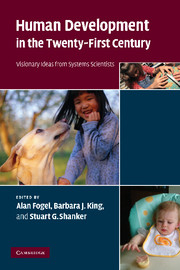Book contents
- Frontmatter
- Contents
- List of contributors
- Introduction: Why a dynamic systems approach to fostering human development?
- Part I Dynamic relationships between genetics and environments
- 1 Developmental dynamics: the new view from the life sciences
- 2 Genes, experience, and behavior
- 3 How dynamic systems have changed our minds
- 4 Individual development as a system of coactions: implications for research and policy
- 5 Gene–environment interactions and inter-individual differences in rhesus monkey behavioral and biological development
- Part II The dynamic system of the child in the family
- Part III The dynamic system of the child in social and physical environment
- Part IV Dynamic systems approaches to mental health
- Part V Conclusions and outlook
- Index
- References
4 - Individual development as a system of coactions: implications for research and policy
Published online by Cambridge University Press: 22 September 2009
- Frontmatter
- Contents
- List of contributors
- Introduction: Why a dynamic systems approach to fostering human development?
- Part I Dynamic relationships between genetics and environments
- 1 Developmental dynamics: the new view from the life sciences
- 2 Genes, experience, and behavior
- 3 How dynamic systems have changed our minds
- 4 Individual development as a system of coactions: implications for research and policy
- 5 Gene–environment interactions and inter-individual differences in rhesus monkey behavioral and biological development
- Part II The dynamic system of the child in the family
- Part III The dynamic system of the child in social and physical environment
- Part IV Dynamic systems approaches to mental health
- Part V Conclusions and outlook
- Index
- References
Summary
Viewing individual development as a system of coactions means that human behavior, personality, intelligence, and so forth are a consequence of multiple “hidden” influences in addition to the obvious ones in the external environment. The “hidden” influences come from the brain and nervous system, hormones, the activity of genes, and the like, which operate beneath the skin. None of these influences, including the environmental ones, are primary or act independently; they are all necessary and thus “coact” in a systemic way to produce developmental outcomes. This is in contrast to the way we usually think about how organisms develop.
When we think of how living things grow and change, we typically tend to think in terms of one cause and one effect. For example, a certain gene causes brown or blue eyes, punishing someone for a behavior lessens the likelihood that they will repeat the behavior, or supportive, loving parents help to create a sense of self-worth in their children. This one cause–one effect approach is straightforward to think about and to study scientifically. In fact the traditional scientific method of experimentation is based on the idea of holding everything in a situation constant except for one factor, the purported “cause” of interest, which is allowed to vary. In a well-designed experiment, changes in the outcome of interest are attributed to the changes in the one factor that was allowed to vary.
Information
- Type
- Chapter
- Information
- Human Development in the Twenty-First CenturyVisionary Ideas from Systems Scientists, pp. 41 - 47Publisher: Cambridge University PressPrint publication year: 2007
References
Accessibility standard: Unknown
Why this information is here
This section outlines the accessibility features of this content - including support for screen readers, full keyboard navigation and high-contrast display options. This may not be relevant for you.Accessibility Information
- 3
- Cited by
